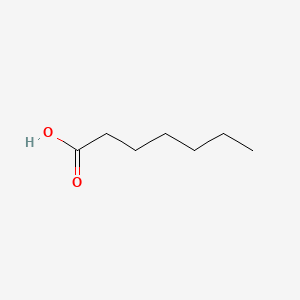| MeSH term | MeSH ID | Detail |
|---|---|---|
| Olfaction Disorders | D000857 | 17 associated lipids |
| Byssinosis | D002095 | 11 associated lipids |
| Mitochondrial Diseases | D028361 | 25 associated lipids |
HEPTANOIC ACID
HEPTANOIC ACID is a lipid of Fatty Acyls (FA) class. Heptanoic acid is associated with abnormalities such as Dehydration. The involved functions are known as Process, Anabolism, inhibitors, Oxidation and fatty acid oxidation. The related lipids are Heptanoates and undecanoic acid.
Cross Reference
Introduction
To understand associated biological information of HEPTANOIC ACID, we collected biological information of abnormalities, associated pathways, cellular/molecular locations, biological functions, related genes/proteins, lipids and common seen animal/experimental models with organized paragraphs from literatures.
What diseases are associated with HEPTANOIC ACID?
HEPTANOIC ACID is suspected in Dehydration and other diseases in descending order of the highest number of associated sentences.
Related references are mostly published in these journals:
| Disease | Cross reference | Weighted score | Related literature |
|---|
Possible diseases from mapped MeSH terms on references
We collected disease MeSH terms mapped to the references associated with HEPTANOIC ACID
PubChem Associated disorders and diseases
What pathways are associated with HEPTANOIC ACID
There are no associated biomedical information in the current reference collection.
PubChem Biomolecular Interactions and Pathways
Link to PubChem Biomolecular Interactions and PathwaysWhat cellular locations are associated with HEPTANOIC ACID?
There are no associated biomedical information in the current reference collection.
What functions are associated with HEPTANOIC ACID?
Related references are published most in these journals:
| Function | Cross reference | Weighted score | Related literatures |
|---|
What lipids are associated with HEPTANOIC ACID?
Related references are published most in these journals:
| Lipid concept | Cross reference | Weighted score | Related literatures |
|---|
What genes are associated with HEPTANOIC ACID?
There are no associated biomedical information in the current reference collection.
What common seen animal models are associated with HEPTANOIC ACID?
There are no associated biomedical information in the current reference collection.
NCBI Entrez Crosslinks
All references with HEPTANOIC ACID
Download all related citations| Authors | Title | Published | Journal | PubMed Link |
|---|---|---|---|---|
| pmid: | ||||
| Lacouture F et al. | Anhydrous lead(II) heptanoate. | 2001 | Acta Crystallogr C | pmid:11353239 |
| Ahmad Tajidi NS et al. | Diaqua-(1,4,8,11-tetra-aza-cyclo-tetra-decane-κN,N,N,N)copper(II) dihepta-noate dihydrate. | 2010 | Acta Crystallogr Sect E Struct Rep Online | pmid:21588132 |
| Taylor RA and Ellis HA | Anhydrous polymeric zinc(II) penta-noate. | 2008 | Acta Crystallogr Sect E Struct Rep Online | pmid:21202761 |
| Sinha-Hikim I et al. | Testosterone-induced muscle hypertrophy is associated with an increase in satellite cell number in healthy, young men. | 2003 | Am. J. Physiol. Endocrinol. Metab. | pmid:12670837 |
| Gu L et al. | Parenteral and enteral metabolism of anaplerotic triheptanoin in normal rats. II. Effects on lipolysis, glucose production, and liver acyl-CoA profile. | 2010 | Am. J. Physiol. Endocrinol. Metab. | pmid:19903863 |
| Kinman RP et al. | Parenteral and enteral metabolism of anaplerotic triheptanoin in normal rats. | 2006 | Am. J. Physiol. Endocrinol. Metab. | pmid:16705058 |
| Zarzycki PK and Zarzycka MB | Application of temperature-controlled micro planar chromatography for separation and quantification of testosterone and its derivatives. | 2008 | Anal Bioanal Chem | pmid:18338160 |
| Banel A et al. | Application of headspace solid-phase microextraction followed by gas chromatography-mass spectrometry to determine short-chain alkane monocarboxylic acids in aqueous samples. | 2011 | Anal Bioanal Chem | pmid:21107976 |
| Eggink M et al. | Targeted LC-MS derivatization for aldehydes and carboxylic acids with a new derivatization agent 4-APEBA. | 2010 | Anal Bioanal Chem | pmid:20238107 |
| Beisson F et al. | Use of the tape stripping technique for directly quantifying esterase activities in human stratum corneum. | 2001 | Anal. Biochem. | pmid:11237319 |
| Titus SA et al. | A new homogeneous high-throughput screening assay for profiling compound activity on the human ether-a-go-go-related gene channel. | 2009 | Anal. Biochem. | pmid:19583963 |
| Liu KS et al. | Novel depots of buprenorphine prodrugs have a long-acting antinociceptive effect. | 2006 | Anesth. Analg. | pmid:16632824 |
| Chu KS et al. | The antinociceptive effect of nalbuphine and its long-acting esters in rats. | 2003 | Anesth. Analg. | pmid:12933406 |
| Marovitz WF and Khan KM | Scanning electron microscopic appearance of rat otocyst of the twelfth postcoital day: elaboration of a method. | 1977 Jan-Feb | Ann Otol Rhinol Laryngol Suppl | pmid:402880 |
| Salanitro JP and Muirhead PA | Quantitative method for the gas chromatographic analysis of short-chain monocarboxylic and dicarboxylic acids in fermentation media. | 1975 | Appl Microbiol | pmid:1167776 |
| Wang HH et al. | Biosynthesis of polyhydroxyalkanoate homopolymers by Pseudomonas putida. | 2011 | Appl. Microbiol. Biotechnol. | pmid:21046374 |
| Thrash JC et al. | Description of the novel perchlorate-reducing bacteria Dechlorobacter hydrogenophilus gen. nov., sp. nov.and Propionivibrio militaris, sp. nov. | 2010 | Appl. Microbiol. Biotechnol. | pmid:19921177 |
| Guzmán A et al. | Hypoglycemic activity in male rats of bicyclo (3, 1, 0) hexane-6-carboxylic acid derivatives. | 1985 Oct-Dec | Arch Invest Med (Mex) | pmid:3842921 |
| Liao LL and Richardson KE | The inhibition of oxalate biosynthesis in isolated perfused rat liver by DL-phenyllactate and n-heptanoate. | 1973 | Arch. Biochem. Biophys. | pmid:4689788 |
